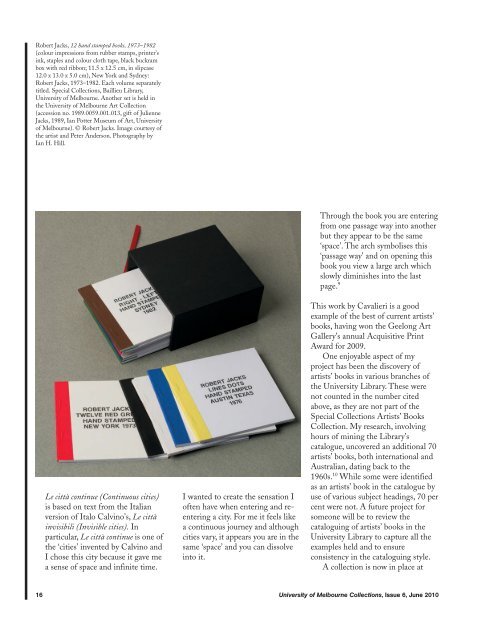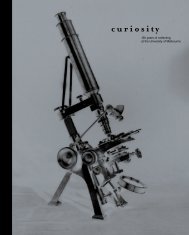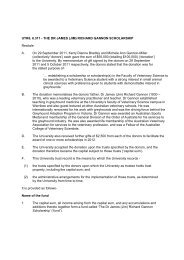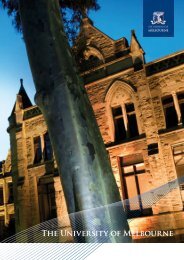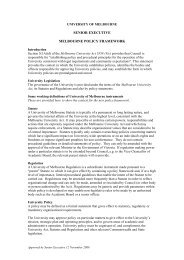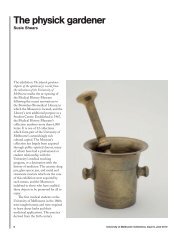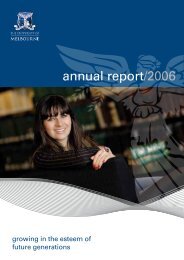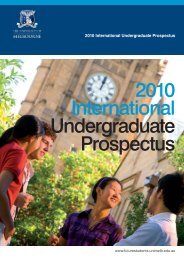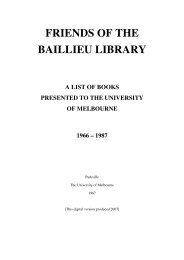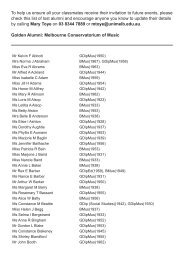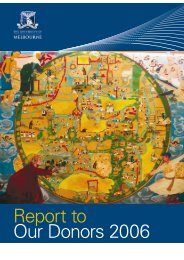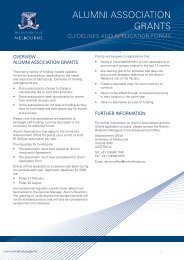COLLECTIONS - University of Melbourne
COLLECTIONS - University of Melbourne
COLLECTIONS - University of Melbourne
You also want an ePaper? Increase the reach of your titles
YUMPU automatically turns print PDFs into web optimized ePapers that Google loves.
Robert Jacks, 12 hand stamped books, 1973–1982<br />
(colour impressions from rubber stamps, printer’s<br />
ink, staples and colour cloth tape, black buckram<br />
box with red ribbon; 11.5 x 12.5 cm, in slipcase<br />
12.0 x 13.0 x 5.0 cm), New York and Sydney:<br />
Robert Jacks, 1973–1982. Each volume separately<br />
titled. Special Collections, Baillieu Library,<br />
<strong>University</strong> <strong>of</strong> <strong>Melbourne</strong>. Another set is held in<br />
the <strong>University</strong> <strong>of</strong> <strong>Melbourne</strong> Art Collection<br />
(accession no. 1989.0059.001.013, gift <strong>of</strong> Julienne<br />
Jacks, 1989, Ian Potter Museum <strong>of</strong> Art, <strong>University</strong><br />
<strong>of</strong> <strong>Melbourne</strong>). © Robert Jacks. Image courtesy <strong>of</strong><br />
the artist and Peter Anderson. Photography by<br />
Ian H. Hill.<br />
Le città continue (Continuous cities)<br />
is based on text from the Italian<br />
version <strong>of</strong> Italo Calvino’s, Le città<br />
invisibili (Invisible cities). In<br />
particular, Le città continue is one <strong>of</strong><br />
the ‘cities’ invented by Calvino and<br />
I chose this city because it gave me<br />
a sense <strong>of</strong> space and infinite time.<br />
I wanted to create the sensation I<br />
<strong>of</strong>ten have when entering and reentering<br />
a city. For me it feels like<br />
a continuous journey and although<br />
cities vary, it appears you are in the<br />
same ‘space’ and you can dissolve<br />
into it.<br />
Through the book you are entering<br />
from one passage way into another<br />
but they appear to be the same<br />
‘space’. The arch symbolises this<br />
‘passage way’ and on opening this<br />
book you view a large arch which<br />
slowly diminishes into the last<br />
page. 9<br />
This work by Cavalieri is a good<br />
example <strong>of</strong> the best <strong>of</strong> current artists’<br />
books, having won the Geelong Art<br />
Gallery’s annual Acquisitive Print<br />
Award for 2009.<br />
One enjoyable aspect <strong>of</strong> my<br />
project has been the discovery <strong>of</strong><br />
artists’ books in various branches <strong>of</strong><br />
the <strong>University</strong> Library. These were<br />
not counted in the number cited<br />
above, as they are not part <strong>of</strong> the<br />
Special Collections Artists’ Books<br />
Collection. My research, involving<br />
hours <strong>of</strong> mining the Library’s<br />
catalogue, uncovered an additional 70<br />
artists’ books, both international and<br />
Australian, dating back to the<br />
1960s. 10 While some were identified<br />
as an artists’ book in the catalogue by<br />
use <strong>of</strong> various subject headings, 70 per<br />
cent were not. A future project for<br />
someone will be to review the<br />
cataloguing <strong>of</strong> artists’ books in the<br />
<strong>University</strong> Library to capture all the<br />
examples held and to ensure<br />
consistency in the cataloguing style.<br />
A collection is now in place at<br />
16<br />
<strong>University</strong> <strong>of</strong> <strong>Melbourne</strong> Collections, Issue 6, June 2010


